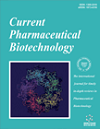- Home
- A-Z Publications
- Current Pharmaceutical Biotechnology
- Previous Issues
- Volume 23, Issue 9, 2022
Current Pharmaceutical Biotechnology - Volume 23, Issue 9, 2022
Volume 23, Issue 9, 2022
-
-
A Review of Chemistry and Pharmacology of Piperidine Alkaloids of Pinus and Related Genera
More LessBackground: Pinus belongs to the family Pinaceae, represented by several species across the globe. Various parts of the plant including needles are rich in biologically active compounds, such as thunbergol, 3-carene, cembrene, α-pinene, quercetin, xanthone. Of all the alkaloids, the piperidine group is one of the important component and holds considerable medicinal importance. Methods: The group of alkaloids was initially ide Read More
-
-
-
Beta-glucans is a Potential Inhibitor of Ovarian Cancer: Based on Molecular and Biological Aspects
More LessOvarian cancer is a lethal type of cancer which is initiated to the ovaries and affects 1 out of every 75 women. Due to the high number of deaths (almost 152,000) related to this cancer, it seems that novel efficient therapeutic methods are required in this field. Beta-glucans are a type of glucose linear polymers which have been proven to have a lot of advantageous activities. Recently, investigations have declared that th Read More
-
-
-
Anti-inflammatory Effects of Mesenchymal Stem Cells and their Secretomes in Pneumonia
More LessAuthors: Kamal Hezam, Rigen Mo, Chen Wang, Yue Liu and Zongjin LiMesenchymal stem cells (MSCs) are multipotent progenitor cells that play crucial roles in the microenvironment of injured tissues. The potential therapeutics of MSCs have attracted extensive attention for several diseases such as acute respiratory distress syndrome (ARDS) and novel coronavirus disease 2019 (COVID-19) pneumonia. MSC-extracellular vesicles have been isolated from MSC-conditioned media (MSC-CM) Read More
-
-
-
CCNE1 Promotes Progression and is Associated with Poor Prognosis in Lung Adenocarcinoma
More LessAuthors: Guoliang Ma, Lulu Yang, Jing Dong and Lili ZhangBackground: Mounting evidence has shown that Cyclin E1 (CCNE1) facilitates various carcinoma progression, but its function in lung adenocarcinoma (LUAD) remains unclear. Objective: Our study aims to explore the significance of CCNE1 in clinical progression and study its biological functions in LUAD. Methods: CCNE1 expressions in LUAD specimens and cells were detected through quantitative realtime poly Read More
-
-
-
A Novel Quinazoline-4-one Derivatives as a Promising Cytokine Inhibitors: Synthesis, Molecular Docking, and Structure-activity Relationship
More LessAuthors: Rita M. Borik and Mohammed A. HusseinBackground: Quinazolines are a common class of nitrogen-containing heterocyclic scaffolds, which exhibit a broad spectrum of pharmacological activities. Objectives: In the present study, quinazoline and quinazolin-4-one derivatives were prepared, characterized, and evaluated for their biological activity, which may pave the way for possible therapeutic applications. Materials and Methods: New derivatives of quinazoline Read More
-
-
-
Solvent Bar Microextraction Combined with HPLC-DAD for Simultaneous Determination of Diuretics in Human Urine and Plasma Samples
More LessAuthors: Nabil N. AL-Hashimi, Amjad H. El-Sheikh, Manal I. Alruwad and Mohanad M. OdehBackground: A simple and powerful microextraction procedure, the solvent bar microextraction (SBME), was used for the simultaneous determination of two diuretics, furosemide and spironolactone in human urine and plasma samples, using high-performance liquid chromatography coupled with diode array detection (HPLC-DAD). Methods: The appropriate amount (2 μL) of 1-octanol as an organic solvent confined wit Read More
-
-
-
Human Serum Albumin Nanoparticles as a Carrier for On-Demand Sorafenib Delivery
More LessAuthors: Tania M. Caputo, Angela Maria Cusano, Menotti Ruvo, Anna Aliberti and Andrea CusanoBackground: Drug delivery systems based on Human Serum Albumin (HSA) have been widely investigated due to their capability to interact with several molecules together with their nontoxicity, non-immunogenicity and biocompatibility. Sorafenib (SOR) is a kinase inhibitor used as the firstline treatment in hepatic cancer. However, because of its several intrinsic drawbacks (low solubility and bioavailability), there is a gro Read More
-
Volumes & issues
-
Volume 26 (2025)
-
Volume 25 (2024)
-
Volume 24 (2023)
-
Volume 23 (2022)
-
Volume 22 (2021)
-
Volume 21 (2020)
-
Volume 20 (2019)
-
Volume 19 (2018)
-
Volume 18 (2017)
-
Volume 17 (2016)
-
Volume 16 (2015)
-
Volume 15 (2014)
-
Volume 14 (2013)
-
Volume 13 (2012)
-
Volume 12 (2011)
-
Volume 11 (2010)
-
Volume 10 (2009)
-
Volume 9 (2008)
-
Volume 8 (2007)
-
Volume 7 (2006)
-
Volume 6 (2005)
-
Volume 5 (2004)
-
Volume 4 (2003)
-
Volume 3 (2002)
-
Volume 2 (2001)
-
Volume 1 (2000)
Most Read This Month
Article
content/journals/cpb
Journal
10
5
false
en


